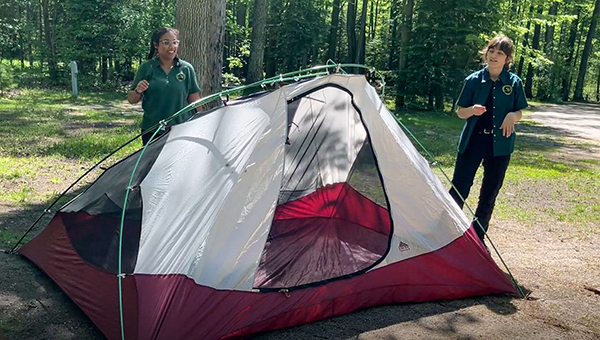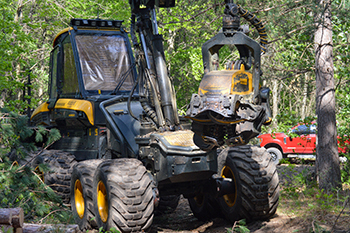

|
Living in Chicagoland for most of my life, my Michigan experiences consisted of weekends visiting Grandma or going to the beach.
Recently, I was finally able to have one of the true Michigan experiences – going “up north.”
Since moving to Michigan to attend Michigan State University, I have been hearing stories about this mysterious “up north” that everyone takes family trips to visit a few times a year.
So, I took a camping trip to North Higgins Lake State Park in Roscommon County with my Michigan Department of Natural Resources colleague, Lydia Taylor.
The experience for two newbie campers involved going through a roll of duct tape, my dinner catching fire and gaining a whole new perspective.
The drive to Roscommon was filled with beautiful tree-lined roads and plenty of wildlife, including bald eagles sitting high in the trees.
Our first stop was the DNR’s Roscommon Equipment Center and Forest Fire Experiment Station, as well as the Michigan State Firemen’s Memorial.
The Roscommon Equipment Center is where DNR staffers think up new types of firefighting equipment and devise ways to modify existing equipment to work better.
Engineering manager Dave Stockoski and the rest of the team led us through the office and their workshop, teaching us about the new improvements to fire trucks to make things safer and easier for the people using them. Examples include changing the location of where things are stored on the truck to make them more easily and quickly accessible, or creating a latch for bulldozer blades that make them easier to operate.
The workshop is split into different sections that do different jobs, and had a few trucks being worked on spread through the different areas. We were able to go through the warehouse and see each step of building and creating parts for the new trucks.
Learning about the innovations made in firefighting through the years was extremely interesting. I was able to see original designs for trucks and other equipment.
“In the last three years, we have redesigned the medium and large engines and started manufacturing and delivering them to the field,” Stockoski said.
The Firefighter Memorial, just down the road from the Fire Equipment Center, is a beautiful monument to the firefighters of Michigan. It had a statue of a firefighter and names of fallen firefighters on the wall.
After this stop, we had some time before we could check into our campsite, so we decided to explore the village of Roscommon.
We were able to drive around and stop at Matt’s Lake Street Grill for lunch. The diner was exactly what you picture when you imagine a small-town diner – everyone seems to know each other, and you can tell who the regulars are.
The employees are all friendly and the food, of course, is amazing. We both ordered the chicken tenders and fries, which are the tell of a good restaurant, and they were in the top five chicken tenders I have ever had.
The town itself was great; it had traditional small-town feel, of course surrounded by nature.
Our next stop was the most daunting, worrying and daring part of the entire trip – setting up the campsite. Neither of us are well-versed with the outdoors since we both are more city people and have never been camping before.
We drove over to our North Higgins Lake campsite and were greeted by the kind and helpful park staff that helped us check in. Once we got to our designated camping spot, we got to work trying to set up.
The tent, which we had borrowed, was the most difficult part. It was a seemingly basic two-person tent but came with no instructions and a broken pole. We tried multiple different ways to get it to work, putting the poles in different directions, crossing them over, going through a few pieces of duct tape and attempting to look up directions online.
When we finally got our tent up, at least mostly stable, it was still lopsided and looked like it could blow over any minute. This was a lesson in teamwork and using our heads.
Once we had our tent set up, we went to buy firewood. We didn’t bring firewood because we were coming from over 120 miles away and didn’t want to risk transporting any forest pests or tree diseases along with us.
We found some at a local gas station about a five-minute drive away. With a full tank and a bundle of firewood, we were ready to tackle the second most daring part of this trip and build our campfire.
Neither of us had ever built a fire before, so we had to turn to the internet for instructions on how to do so. Luckily, we had brought these fire starter blocks, which are basically a block of kerosene, and a lighter with us.
Our fire started off rough. We could not get it to stay lit at first, so we kept adding dry leaves and twigs to our setup until finally it held a small fire.
Then it was time to start cooking dinner. That night’s menu included campfire nachos and tacos with s’mores for dessert. We had never cooked on a fire so again, the internet gave us multiple recipes to work with, including foil-wrapped nachos.
As we were cooking, the fire kept dying down. We were focused on adding more twigs and moving the logs around when we noticed our foil- and parchment paper-wrapped nachos had caught fire.
We had to use the marshmallow sticks to tamp out the fire and lift the nachos off the heat. The singed chips and lukewarm taco meat were relatively tasty, and when we repackaged the nacho ingredients into a taco form, it was just as good. The s’mores, on the other hand, went a lot more smoothly and turned out delicious.
After a surprisingly restful night of sleep in the tent and waking up to the sounds of birds chirping and animals rustling in the trees above us, we got an early start to visit a timber sale near Alger.
This was by far my favorite part of the trip. I was able to learn so much about forestry and the timber industry. DNR forest management unit managers Blair Tweedale and Jason Lewicki took us through the different parts of a timber operation. This helped me to really understand the purpose and value of the industry.
We got to learn about all the different parts of the logging process. The wood passes hands at least eight times, and there are a lot of different machines and groups involved.
One of my favorite machines was one we got to sit in and watch in action up close. This machine picks up the tree, cut at ground level, and measures it, cuts it into different lengths depending on what is needed and strips the branches off to be used for something else.
I learned about how logging works, and that it is done in a way that mimics natural events such as wildfire or heavy winds. The DNR’s forestry and wildlife divisions often work together to make sure that timber cuts will also provide habitat for birds and animals.
The whole process was eye-opening for me. I really did get the true Michigan experience and gained a new perspective on both Michigan and the outdoors. The most important thing about my trip was learning that the outdoors can be enjoyed by everyone, even someone like me who isn’t outdoorsy.
Check out previous Showcasing the DNR stories in our archive at Michigan.gov/DNRStories. To subscribe to upcoming Showcasing articles, sign up for free email delivery at Michigan.gov/DNREmail.